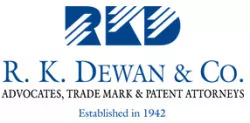The term logo is derived from Greek as an abbreviation of the term "logo type", meaning a "word and an imprint". A logo is included in the definition of a trademark used by businesses to distinguish their goods and services from the businesses of others and to provide distinct recognition for such businesses or even an individual.
A logo may be either pure graphic such as a symbol or icon or an emblem or it may be a mixture of graphic or the name or abbreviation of a business or an individual. Sometimes the logo can also be the signature of a famous designer associated with the business. Most designer brands particularly those associated with fashion and luxury goods use a logo on their products for instant recognition.
A logo is registered in the same way and in the same process as a normal word mark is registered. The first time that a logo was applied for registration and got registered as a trademark was in 1876 for the word "bass" with a red triangle. Logos have universal appeal and transcend across all cultures and languages. For example, the Mercedes 3 pointed star in a circle is a recognized logo for good quality cars and does not need any language or explanation to flaunt its presence. Another widely recognized logo is the Red Cross symbol which represents a humanitarian service and is recognized throughout the world.
During the process of registration of logo, the rules of comparison are less stringent than that for word marks. For example, in the case of logos, the issue of deceptive similarity is only based on the visual comparison of the logo sought to be applied for the registration as compared to previously registered logos. Other issues like phonetic similarity or conceptual similarity have normally no place in such comparison. Colour and colour schemes play an important part in creating distinctiveness when it comes to registering of logos. Thus a distinctive colour scheme or a distinctive way of representing a common geometric graphic may be considered as a registerable logo. Words, on the other hand, are always subject to the limitation of script, phonetics and cultural variations.
Whereas, word marks are frequently subject to be redesigned over the ages as part of the modernization process, most businesses are reluctant to frequently redesign their logos. Even if modernizing warrants such redesigning the modernized version of the logo will have a common theme with the original version. In any case, all versions need to be protected by registration under the Trademarks Act of each of the countries in which the logo is intended to be used.
The content of this article is intended to provide a general guide to the subject matter. Specialist advice should be sought about your specific circumstances.

